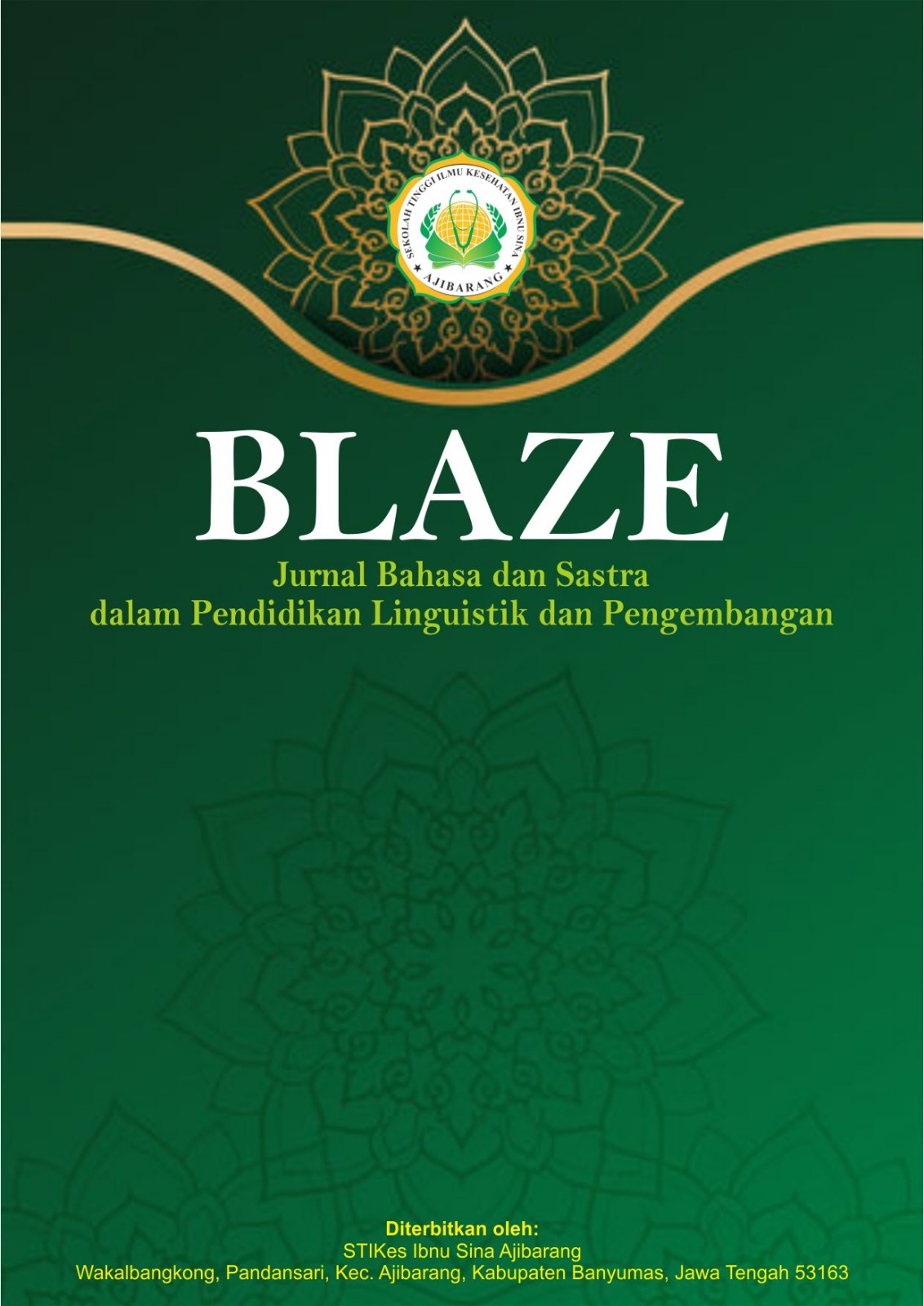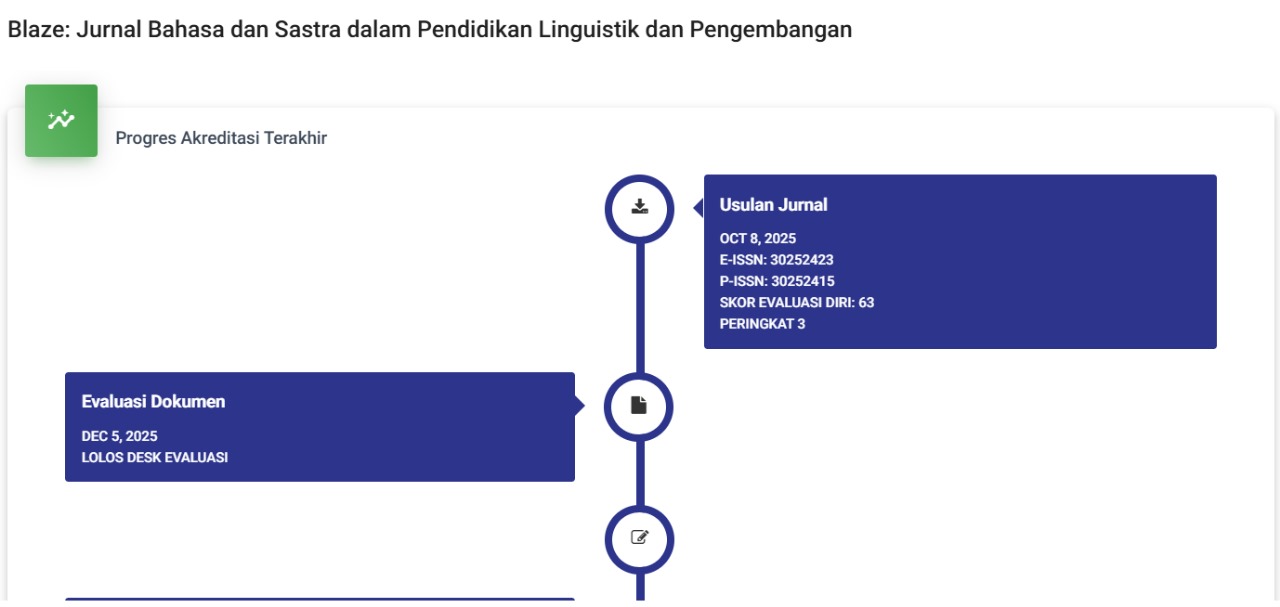Kesantunan Berbahasa dalam Komunikasi Grup Whatsapp Pemerintah Desa: Tinjauan Prinsip Leech
DOI:
https://doi.org/10.59841/blaze.v3i3.3045Keywords:
Pragmatics, Principle of Politeness, Geoffrey LeechAbstract
This study aims to identify the application and violation of the principles of politeness according to Geoffrey Leech in the village government WhatsApp group communication. The phenomenon of language use in institutional digital communication often ignores the elements of politeness, even though communication is carried out in a professional context. This study uses a descriptive qualitative approach with a case study method. The data studied are in the form of speech or written messages sent by members of the Bendung Village Government WhatsApp group, Jetis District, Mojokerto Regency. Data collection techniques are carried out through reading and note-taking techniques, while data analysis is carried out using interactive analysis techniques including data reduction, data presentation, and drawing conclusions. The results of the study show the application of the six maxims in communication in the village government WhatsApp Group based on Geoffrey Leech's principles of politeness, between the maxim of agreement, the maxim of wisdom, the maxim of praise, the maxim of generosity, the maxim of sympathy, and the maxim of humility appearing in forms of communication. This application shows that digital media does not eliminate the values of politeness, but rather becomes an adaptation of a more flexible but ethical communication strategy. Furthermore, micro-frequencies of violations of the maxim of agreement, the maxim of wisdom and the maxim of sympathy were also found in the context of conveying sensitive, technical or administrative information. This study emphasizes the importance of awareness of polite language in official digital communication, especially in the village bureaucratic environment.
References
A’yuni, N. B. Q., & Parji, P. (2017). Tindak tutur ilokusi novel Surga yang Tidak Dirindukan karya Asma Nadia (kajian pragmatik). Linguista: Jurnal Ilmiah Bahasa, Sastra, dan Pembelajarannya, 1(1), 6. https://doi.org/10.25273/linguista.v1i1.1307
Ainin, N., Rokhmansyah, A., & Purwanti. (2019). Tipe tuturan remaja perempuan yatim dalam interaksi sehari-hari: Kajian pragmatik. Diglosia: Jurnal Kajian Bahasa, Sastra, dan Pengajarannya, 2(1), 1–14. https://doi.org/10.30872/diglosia.v2i1.14
Alfiansyah, M. A., Wahya, & Sufyan, A. (2021). Analisis kesopanan tindak tutur direktif dalam pembelajaran daring: Kajian pragmatik. Literasi: Jurnal Ilmiah Pendidikan Bahasa, Sastra Indonesia dan Daerah, 11(2), 53–68. https://doi.org/10.23969/literasi.v11i2.3412
Bawamenewi, A. (2020). Analisis tindak tutur bahasa Nias: Sebuah kajian pragmatik. Jurnal Review Pendidikan dan Pengajaran, 3(2), 200–208. https://doi.org/10.31004/jrpp.v3i2.1217
Chaer, A. (2010). Kesantunan berbahasa. Jakarta: Rineka Cipta.
Darmadi, H. (2011). Metode penelitian pendidikan. Bandung: Alfabeta.
Devi, R. P. I., & Utomo, A. P. Y. (2021). Tindak tutur ilokusi pada interaksi jual beli di pasar tradisional Bandarjo Ungaran dalam kajian pragmatik. Riksa Bahasa, 6(2), 185–196.
Leech, G. (1993). Prinsip-prinsip pragmatik. Jakarta: Penerbit Universitas Indonesia (UI-Press).
Mardiana, D., Rokhman, F., Rustono, & Mardikantoro, H. B. (2025). Speech act of political figures in the discourse of educational development: An interpersonal pragmatic approach. Cogent Arts and Humanities, 12(1). https://doi.org/10.1080/23311983.2025.2463728
Miles, M., & Huberman, A. M. (1992). Analisis data kualitatif: Buku sumber tentang metode-metode baru. Jakarta: UI-Press.
Nahdi, K., & Al-Pansori, M. J. (2024). Cultivating early childhood character through Geoffrey Leech’s politeness maxims: A case study and innovative design. Scaffolding: Jurnal Pendidikan Islam dan Multikulturalisme, 6(2), 373–395. https://doi.org/10.37680/scaffolding.v6i2.5846
Nuralifa, Rahim, R. A., & Muhdina, D. (2021). Penggunaan bahasa pada media sosial (medsos): Studi kajian pragmatik. Gema Wiralodra, 12(2), 305–319. https://gemawiralodra.unwir.ac.id/index.php/gemawiralodra/article/view/188
Paramita Hapsari, P., Harsono, H., Sawitri, S., & Basuki, S. H. (2022). Analisis kesantunan berbahasa dalam naskah Sêrat Dongeng Asmadaya (Kajian pragmatik). Jurnal Review Pendidikan dan Pengajaran, 5(1), 14–18. https://doi.org/10.31004/jrpp.v5i1.4136
Rahardi, K. (2008). Pragmatik: Kesantunan imperatif bahasa Indonesia. Jakarta: Erlangga.
Rohmadi, M. (2014). Kajian pragmatik percakapan guru dan siswa dalam pembelajaran Bahasa Indonesia. Jurnal Paedagogia, 17(1), 53–61.
Sumarlam, Pamungkas, S., & Susanti, R. (2023). Pemahaman dan kajian pragmatik. Bukukatta. http://repository.stkippacitan.ac.id/id/eprint/1355
Winata Putri, D. A., & Yudi Utomo, A. P. (2021). Maksud kata makian pada media sosial Twitter (kajian pragmatik). Widya Accarya, 12(2), 162–176. https://doi.org/10.46650/wa.12.2.1100.162-176
Downloads
Published
How to Cite
Issue
Section
License
Copyright (c) 2025 BLAZE : Jurnal Bahasa dan Sastra dalam Pendidikan Linguistik dan Pengembangan

This work is licensed under a Creative Commons Attribution-ShareAlike 4.0 International License.








